November 25, 2019
 by Justin Champion / November 25, 2019
by Justin Champion / November 25, 2019

We live in a digitally-informed world.
Have a question? Type it into a search engine like Google and you’ll be presented with thousands, millions, and possibly billions of websites competing for your attention.
Think about that for a minute – you have billions of options to choose from.
The over-saturation of content has made Google’s job of connecting you, the searcher, with the most relevant highly-authoritative results possible, increasingly difficult.
So, over the years Google released a series of search engine algorithm updates with the goal of solving for organic search intent.

All this change brings opportunity for content marketers to be found by their ideal audience (aka their buyer personas). That’s critical to creating successful content in today’s online environment.
Most content marketers forget that it’s not just about creating content for the search engine. If you want your content to rank on the first page of Google, then you need to produce high-quality, comprehensive content that search engines deem authoritative and that solve for the intent of a searcher’s query.
Here’s how you can avoid inbound marketing mistakes and solve for both: create targeted clusters of relevant content that each cover a specific topic in-depth.
These targeted clusters are called topic clusters. They need to lead to a comprehensive page on your website, known as a pillar page. A pillar page (also known as a content pillar or power page) is a website page that covers a specific topic in-depth and is linked to a cluster of related content.
In this post, we’re going to review:
Note that this article is not a solution for your business’s local SEO strategy, but rather a strategy to get more traffic to your inbound marketing content. With that said, let’s get started with the mechanics of a topic cluster and pillar page content marketing framework.
The first step in utilizing this framework is identifying a broad topic that you want to be known for and build authority around. Instead of thinking about specific keywords you want to rank for, focus on terms with high monthly search volume, usually two to three words in length.
Let’s say you’re a service business that offers marketing training as one of your products for purchase. Your main focus is on training people to become effective inbound marketers. With this in mind, “inbound marketing” would be a great example of a broad topic you would want to be known for and build authority around.
| Tip: When identifying a broad topic, consider selecting terms with a monthly search volume of 1,800 or above. Doing so will give you more flexibility in the next step. |
Next, if your goal is to rank for a broad topic like “inbound marketing”, then you need to be specific as to what you’re talking about by bringing context to the equation. In this case, “inbound marketing strategy” would be a great example of bringing context to the broad topic of “inbound marketing.”
The trick to doing this effectively is finding specific terms in support of your broad topic that have enough search volume to justify the time it takes to create the content. This is because you will be creating a pillar page around this contextualized topic with the intention of getting that page to rank on the first page of Google’s search results.
| Tip: When identifying a specific topic that you want to rank for, consider selecting terms with a monthly search volume between 100 and 1,800. |
Keep in mind, the higher the monthly search volume, the more difficult it will be to rank for. On that note, choosing keywords that have lower monthly search volumes can still make a big impact on your search engine visibility. You may think that 300 monthly searches for a specific keyword is low, but ranking for a keyword with this monthly search volume can pay off in the long run. That’s because the average first-page ranking will also rank well for about a thousand other relevant keywords.
Remember, search engines are much smarter nowadays. Their main goal is to solve for searcher intent. Yes, keyword mapping is still important, but if search engines think your content solves for the intent of a search query, even if that search query doesn’t have the specific keywords you used to optimize your content, then chances are they’ll choose to rank it anyways. That’s why it’s important to think in terms of topics over keywords.
Lastly, once you determine how you intend to rank for a term that’s specific to the broad topic you’re going to write about, you’ll want to identify your topic cluster, which will be made up of relevant subtopics.
A subtopic should be strong enough to be published on its own—in the form of something like a YouTube video or blog post—but when combined with other similarly-themed subtopics, it should be relevant to and support the specific topic you’re writing about.
In this case, “inbound marketing workshop” and “how do you create a professional online video?” are examples of strong subtopics that provide value on their own and are semantically related to the specific topic “inbound marketing strategy.”

To complete the topic cluster, and solve for both the searcher and the search engine, connect the pillar page and subtopics together through a series of hyperlinks. By linking your cluster together you’re passing authority through to each page a part of the cluster. If one piece of content ranks well, the ranking of other related and connected pieces of content will rise through the ranks as well.

Make it a best practice to naturally include a link to your pillar page in all of your subtopic content assets, even if they’re not necessarily helpful from an SEO perspective such as a link in the description of a YouTube video. Solve for the human searcher first. Adding a link in the description of a YouTube video shows the viewer a relevant next step they can take to continue consuming your content. However, a link like this won’t pass SEO authority through to the page.
Here is an inbound marketing example of how SEO works. It shows how a topic cluster can successfully guide a website visitor through the path to purchase by making a well-informed, confident decision.
Picture this: You’re a marketing manager who’s coming up on your one-year work anniversary. You’re looking to make a big impression on your manager, so you ask for more responsibility. Your manager appreciates you taking the initiative and asks you to create an outline for the business’s inbound marketing strategy for the coming year.
So...how exactly will you do that?
You start your research like most people—on Google. You type in the following query: “how to create an inbound marketing strategy.” This is what you find:
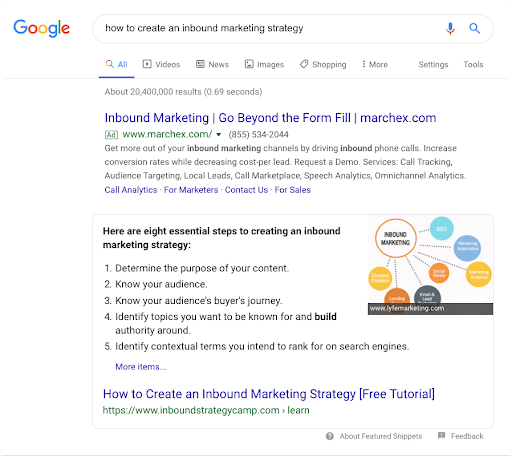
At the top, just before the coveted number-one listing, you see that Google generated a featured snippet for content from a marketing training company called Inbound Strategy Camp. Featured snippets are selected search results that are showcased on top of Google's organic results, just below the ads section. Google chooses to feature snippets like these from various pieces of web content if it believes the content is structured in a way that solves the intent of the search query.
Let’s assume this featured snippet piques your interest, so you click through to the page to learn more.
At the top of the page, you notice there’s an embedded YouTube video instead of a stock image (which is generally what you’d find). That’s because 54% of consumers want to see videos from brands—that’s more than any other type of content.

Additionally, adding a video to your website can increase the chance of a first page Google result by 53 times. This is especially helpful if you include a video near the top of your website pages.
Why? Because if people take the time to watch your video, then it’ll reduce your page’s bounce rate. Your website's bounce rate is the percentage of people who land on one of your website pages, then leave. They don't click on anything. They just get to one of your pages, then leave quickly. Having a low bounce rate is a strong indicator to Google that people find value in your content. And if Google thinks your content provides value, then that can lead to first page rankings for the topics you want to show up for.
Here’s a tip—consider embedding YouTube videos on your website (especially near the top of the page). Not only is YouTube a popular search engine (second only to Google), but YouTube videos generally rank near the top of search results—another opportunity to claim real estate on a search engine results page.
In the example shown above, you’ll see that below the video, there’s an anchor-linked table of contents that easily allows you to jump around to different sections on the page. This is important because this page has more than 3,500 words.
 Why so much content on one page? The nature of search has changed. The days of keyword stuffing and writing a 500-word blog post optimized for a long-tail keyword in the hopes of a first-page Google result listing are over.
Why so much content on one page? The nature of search has changed. The days of keyword stuffing and writing a 500-word blog post optimized for a long-tail keyword in the hopes of a first-page Google result listing are over.
Today, search engines value longer-form content. In fact, SerpIQ performed a study and found that the average first-page ranking has over 2,000 words. It’s clear that search engines value long-form content.
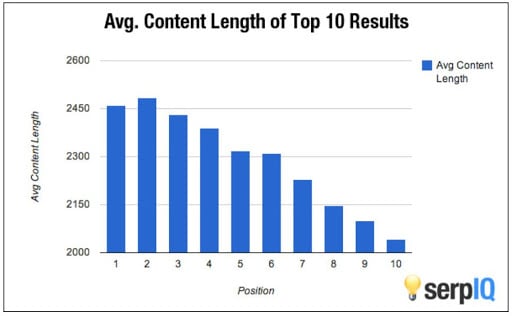
Moving down the page, you’ll see a bullet-pointed list that gives an overview of what the reader is going to learn in the article.
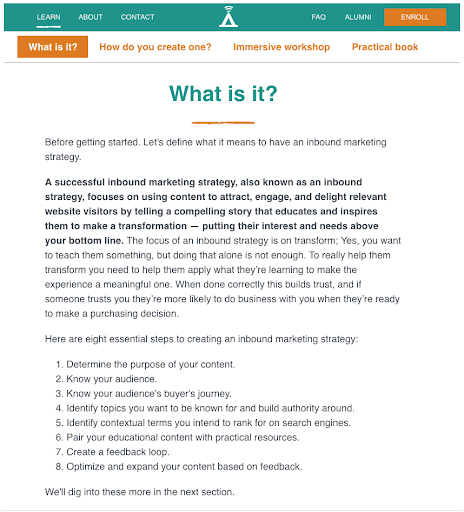
Does this look familiar? You may remember this information from Google’s featured snippet that originally attracted you to this page. Including a bulleted list near the top of your page that outlines what the reader is going to learn can land you the featured snippet (above Google’s first organic listing).
As you scroll down the page, you’ll notice there’s a link to a video production resource. Video marketing has been a challenge for many businesses. If you can include video as part of your inbound marketing strategy recommendation, then you know your manager will truly appreciate it. So, you click through to the page to learn more.
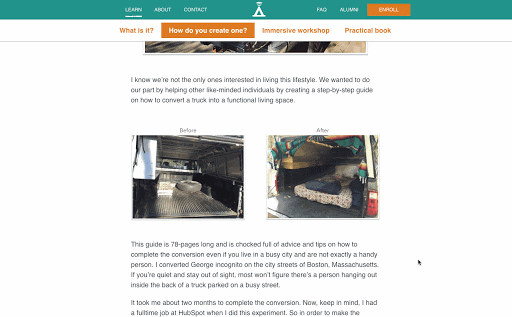
As you consume this page you start to get ideas in your head for the inbound plan your manager asked you to create. As you begin to think about what you’re going to do next you notice a pop-up call-to-action shows up on the page and offers you a possible solution—an on-demand workshop to apply what you’re learning to your business. Intrigued by the offer, you click on it.
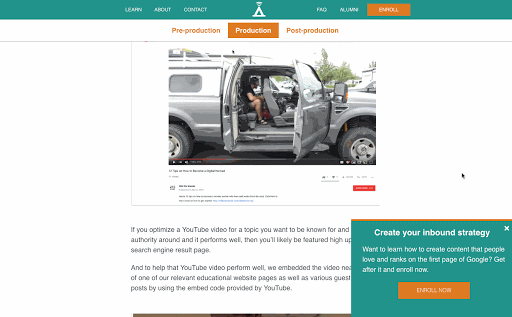
Once you arrive at the page, you notice there’s another video featured at the top of the page. That’s because 90% of customers say video helps them make buying decisions, and 64% of customers say that seeing a video makes them more likely to buy.
You watch the video and realize that practical guidance with an on-demand workshop is exactly the support you need to put your inbound marketing strategy together. Due to an effective topic cluster inbound marketing strategy, you were able to find the resources you needed to make an informed buying decision.
|
TIP: Use customer journey analytics software to ensure that your inbound efforts are creating leads. |
There’s no definitive right or wrong way to go about creating a topic cluster or pillar page. That being said, below is a list of answers to frequently asked questions I receive often.
At a minimum, link your subtopics to your pillar page. This way you’re sending traffic to the go-to source on your website. From there, you can link to specific subtopic pages. Just make sure it makes sense and provides value to the reader.
It can be either. It really depends on the structure of your website. For example, some businesses use their blog for educational content and website pages for product and service pages. Whatever structure you decide on, just make sure to stick to it.
Absolutely. Just make sure it makes sense and provides value to the reader.
Focus on quality, not quantity (this extends to all the educational content on your website). If your website has a lot of content that’s not generating positive results, then it’s that likely it’s hurting your overall website ranking. You should be frequently running content analytics on your website. Sometimes, you may even prune the underperforming content or make an effort to update them.
There are three commonly used pillar page types: 10x content pillar page, resource pillar page, and product or service pillar page.
Creating great content is not enough. You need to prove the value of that content to Google. The way you do that is by increasing your page’s authority via inbound links. An inbound link is a link coming from another site to your own website. Inbound links help increase domain authority. Domain authority is a prediction of how well your website will rank on search engines. The higher your domain authority, the more credible your content will appear to search engines. And if search engines think your content is credible, then it's likely you'll see an increase in rankings.
There is always some guesswork involved when it comes to inbound marketing. It’s sometimes hard to tell which strategies or targeted keywords will take your content to the top of the SERPs. However, if you follow the topic cluster and pillar page framework and use the right SEO tools, you’ll eventually achieve inbound marketing success.
Justin Champion is a digital nomad, author of Inbound Content, Principal Content Professor for HubSpot Academy, Adjunct Lecturer for the University of Florida, and one half of Wild We Wander. Justin created HubSpot Academy's Content Marketing Course, which has awarded over 60,000 certifications to professionals across the globe since November 2016. You can find him on Twitter @JustinRChampion.
A fully loaded inbound marketing engagement can cost upwards of $100,000 per year for all the...
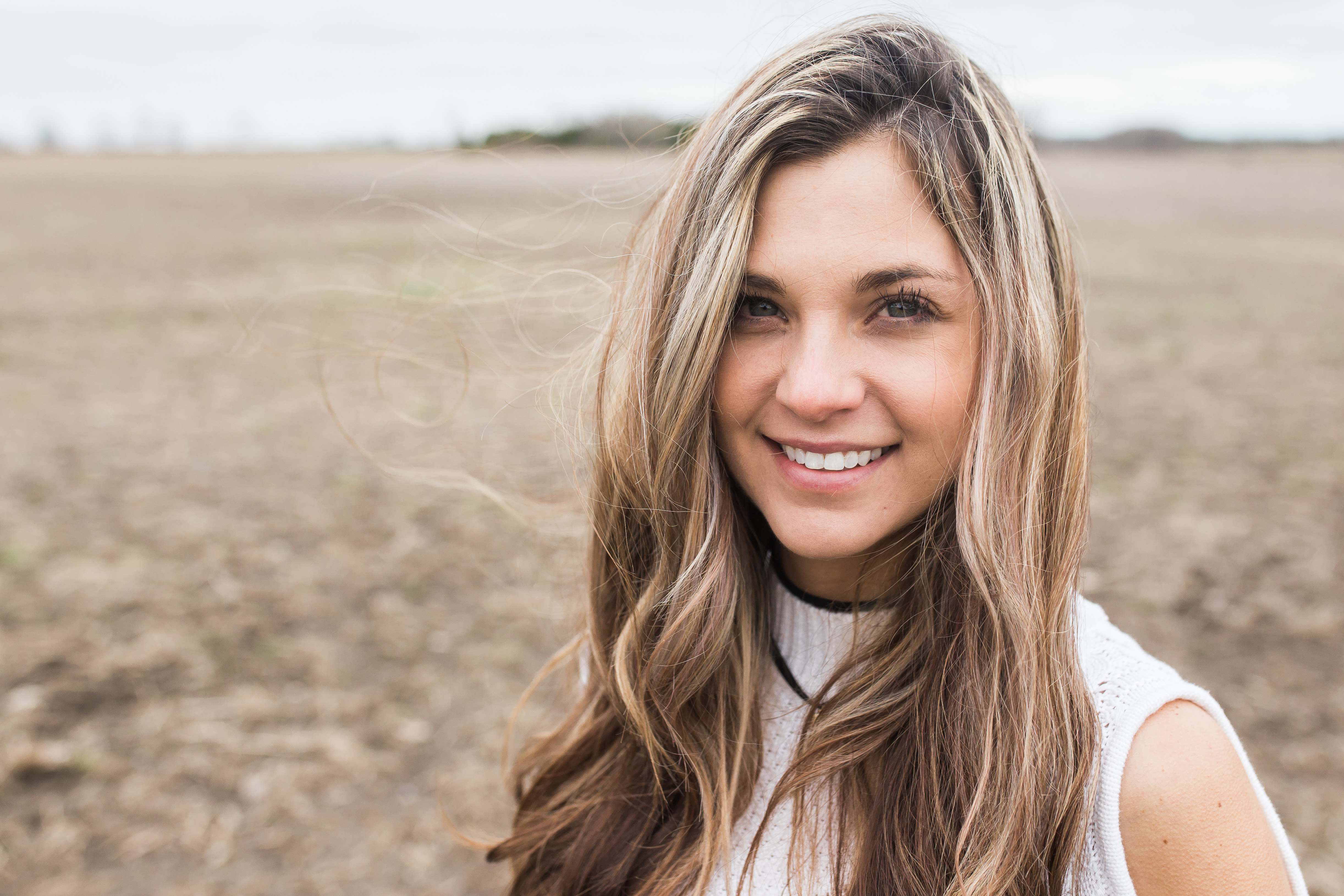 by Andrea Moxham
by Andrea Moxham
When it comes to marketing, you are not your prospect.
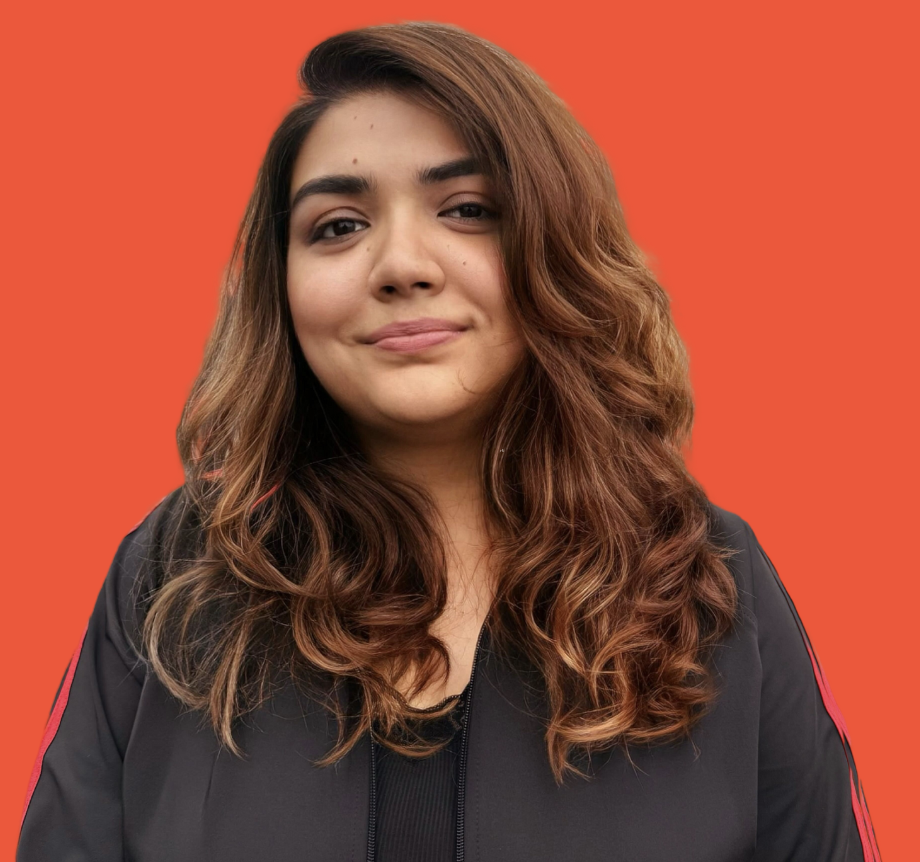 by Washija Kazim
by Washija Kazim
A fully loaded inbound marketing engagement can cost upwards of $100,000 per year for all the...
 by Andrea Moxham
by Andrea Moxham



